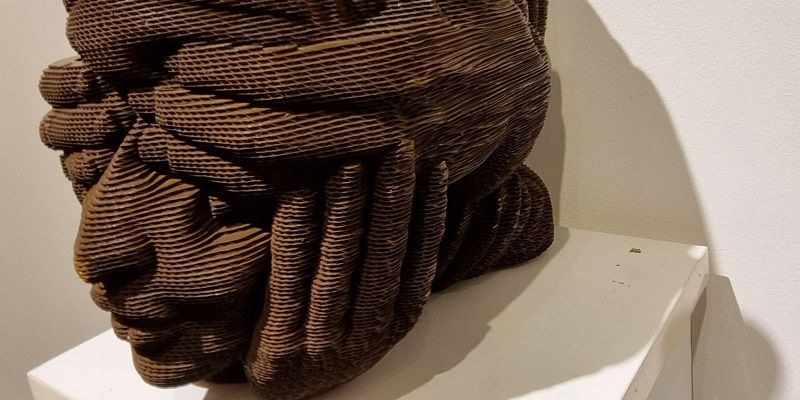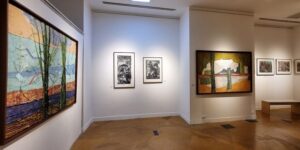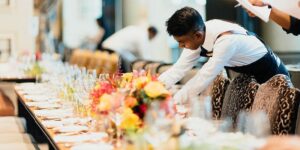Launched in 2014, PhotoSparks is a weekly feature from YourStory, with photographs that celebrate the spirit of creativity and innovation. In the earlier 800 posts, we featured an art festival, cartoon gallery. world music festival, telecom expo, millets fair, climate change expo, wildlife conference, startup festival, Diwali rangoli, and jazz festival.
Two ongoing exhibitions in New Delhi’s Triveni Art Gallery (Fabricated Tales by Bandana Jain) and Gallery Art Positive (Baroda Buzz curated by Georgina Maddox and Anu Bajaj) showcase an inspiring range of themes and techniques.

“Ordinary materials can carry extraordinary meanings, turning the mundane into something profound,” artist and sustainable design advocate Bandana Jain tells YourStory. She has over a decade of experience of working with a rather unconventional medium: corrugated cardboard.
The term ‘fabricated’ in her exhibition title refers to the physical manipulation of cloth as well as the creation of stories that have been woven into the fabric of her memory. All the pieces reflect her commitment to sustainability, utilising eco-friendly mediums to create thought-provoking art.
“I employ a technique of layering and stacking materials, which I hand-compress to achieve a distinct tactile quality in my work,” she says, describing her sculptures, wall pieces, installations, and functional art.

As shown in this photo essay, her creative works compel viewers to interpret them at multiple levels, from texture to messages. Jain hopes this fusion of creativity and conscience can transcend the boundaries of galleries and museums to inspire progressive change in the world.
“My process involves a deep dedication to the material, resulting in unique folds and drapes that are a hallmark of my style. This technique, honed through constant experimentation and commitment, is difficult to replicate, making each piece truly distinctive,” she describes.
Some of her displayed artworks are priced from Rs 2.5 lakh to Rs 12 lakh. “I can also create works at any scale in terms of size or complexity, and the pricing varies accordingly with larger or more complex projects reaching a crore or more,” she says.

“Beyond aesthetics, my primary goal is to spark a dialogue about sustainable practices through my art. I align my creative process with a broader message of environmental consciousness and corporate social responsibility,” Jain explains. She hopes viewers are inspired to embrace sustainability in both art and life.
The artistic journey is full of twists and turns, ups and downs. “Art is inherently unique, and every true artist constantly experiments and explores new ideas. This creative process naturally involves the risk of failure,” Jain acknowledges.
“However, the greatest lesson an artist can learn from these experiences is to overcome the fear of the unknown. Patience becomes crucial, as errors and setbacks are seen as part of the journey,” she adds.

There are no fixed rules or guaranteed time frames for artistic success. “Even flawed artwork holds value if it resonates with the viewer,” Jain affirms.
What matters most is staying true to the craft and continuing to innovate. “As the Gita teaches, one should not be attached to the outcome. The focus should be on the process, not the result,” she suggests.
“Success comes in its own time, and often in ways we least expect. By maintaining this mindset, an artist can grow both creatively and personally, embracing every challenge as an essential part of artistic evolution,” Jain explains.

She is grateful for the overwhelming recognition, love and respect she has received from the art world. This has reaffirmed her belief in staying true to her craft.
“I believe that in India the art world needs to actively include a broader audience and educate them about the value of art. It is essential to make art more accessible, with public installations and increased government support for artistic initiatives,” Jain advocates.
She has noticed that many people are willing to spend crores on the flooring of their homes, but show less interest in the art that hangs directly in front of them. “This often happens because they are simply unaware or not engaged with the art world,” she observes.

“By fostering greater awareness and inclusivity, we can bridge this gap. We can create a culture that truly appreciates the power and presence of art in our everyday lives,” Jain emphasises.
Jain also offers tips for aspiring artists with respect to vision, causes, learning, and innovation. “Embrace your unique vision. Stay true to your personal style and perspective, as authenticity is key to creating impactful and original work,” she urges.
It is important to continuously explore new materials, techniques, and ideas to push creative boundaries and keep the work fresh and relevant. At the same time, artists should stay connected to social and cultural issues.

“Engage with the world around you. Use your art as a medium for social commentary,” Jain recommends.
This also involves a commitment to lifelong learning. “Keep evolving by learning from other artists, art movements, and cultural trends. Stay open to feedback and growth,” she adds.
A balance between passion and discipline matters as well. “Passion fuels creativity, but consistent effort, discipline, and hard work are essential to achieving long-term success in the art world,” Jain signs off.

Bandana Jain
In different ways, the other exhibition (Baroda Buzz) curated by Georgina Maddox and Anu Bajaj connects audiences to new ways of thinking about the artistic process through the important role of creative communities.
“The aim of our exhibition is to showcase how artists working at and around the Baroda Narrative School have evolved and embrace a variety of styles and mediums,” Maddox explains.
Featured artists are Bansi Dholakiya, Damayanti Debnath, Gopa Roy, Govind Vishwas, Sri Harsha Kancharla, Harisha Chennangod, Himanshu Jamod, Kalpana Vishwas, Nandhini Sreekumar, Rutvi Bakharia, Shreya Ramani, Satyanarayan Gavara, and Subhakar Tadi.

Founded in 1956 by NS Bendre, Baroda School is a group of artists associated with the Faculty of Fine Arts, MS University, Vadodara. It has carved out a space independent of revivalist inclinations and academic realism.
Gallery Art Positive’s previous exhibitions featured the works of Iranian photographer Sarah Jabbari from his visits to Kashmir and other cities, recording the lives of Kashmiri Pandits.
“We have a group show coming up at the Mumbai Design Fair featuring Ankon Mitra, Anwar, Neerja Divate, and Akasha Patil,” gallery director Anu Bajaj says. There is also an abstract art show scheduled for December.

‘Baroda Buzz’ exhibition
Maddox and Bajaj selected the works for the current exhibition based on visits to studios and art institutions in Vadodara such as Vis-a-Vis, Studio Art, Gallery White, and Maharaja Sayajirao University (MSU).
“The city has produced some of India’s leading artists. It is now giving rise to a whole new multiverse of artistic endeavour,” Maddox explains. The exhibited artworks include abstract geometry, mixed media, paper pulp, small-format works, and maps on diaphanous scrolls.
Collectively, they reflect agrarian roots, urban symbolism, and maritime life. The artworks blend personal experiences of cultural and social practices, while also mirroring larger current concerns of gender equality and the global environment.
Now what have you done today to pause in your busy schedule and harness your creative side for a better world?









(All photographs were taken by Madanmohan Rao on location at the galleries.)










